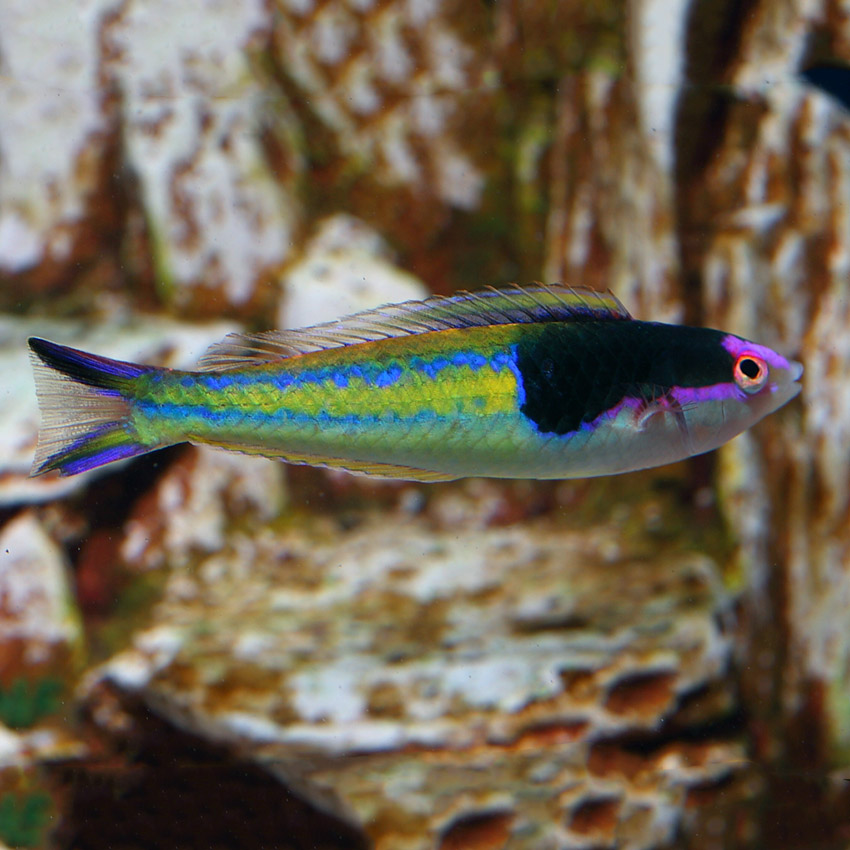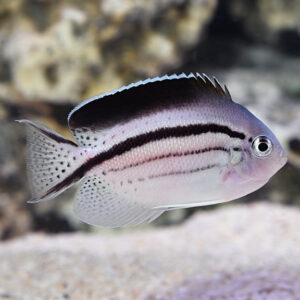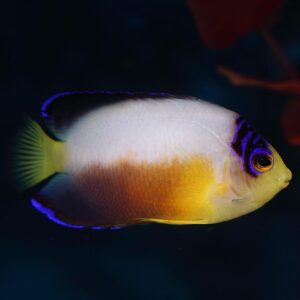Royal Pencil Wrasse Male, Pseudojuloides severnsi, can also go by the name Severn’s Pencil Wrasse. Males and females display different colour morphs.
Overall, males tend to be a bit bigger than the ladies. They are light green in colour and sport blue, green stripes across their body. Mature males have a large black saddle, covering their head and roughly a third of their back. They also have stunning bright pink faces. In comparison, females are not as ornate but are still gorgeous fish. Glowing yellow eyes stand out on their vivid peachy orange bodies. Which in turn, nicely sets off their yellow bellies. Royal Pencil Wrasse fins are mostly translucent. However, males show off vivid blue and yellow shades. Whereas the female have bright orange spines.
Pseudojuloides Wrasse are native to Indian and Pacific waters. Their slender form and striated patterns earn the group the name ‘Pencil Wrasse’. Other characteristics for this group include: small size, truncate tail fin and a single pair of canines, followed by incisiform teeth.
Royal Pencil Wrasse Male, Pseudojuloides severnsi, Ecology.
Royal Pencil Wrasse are from the Indo West Pacific, from Indonesia to the Ryukyu Islands. They live amongst coral and rubble on shallow reefs. The intricate structures on the reef help the fish hunt microfauna, such as formifera, while avoiding predation themselves. Failing that, these fish will also quickly disappear by burying themselves in the sediment.
In nature, these small fish can be seen in lose harems. Royal Pencil Wrasse are protogynous hermaphrodites. Which means when the dominant male perishes, the largest female in the group will turn male. As a result, all juvenile Royal Pencil Wrasse are immature females.
Severn’s Pencil Wrasse In the Aquarium.
It is important to copy the natural environment by providing plenty of nooks and crannies. There should also be a good sand bed for the wrasse to hide and sleep in. Hobbyists should get a jump guard to stop any unfortunate losses.
Royal Pencil Wrasse Male do best when fed a varied diet. They will accept enriched frozen mysis shrimp and enriched frozen brine shrimp. They will also devour live foods, such as copepods and amphipods, that can be cultivated in attached refugium. Over time they will accept high-quality pellet or flake. We adapt all our wrasse to aquarium life before they leave us. We focus on their health, and most are eating a good quality flake food and/or pellet, such as JBL Maris, before being offered for sale.





Reviews
There are no reviews yet.